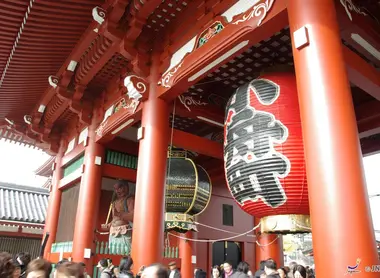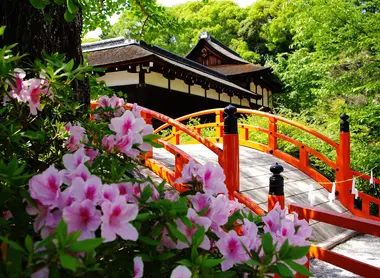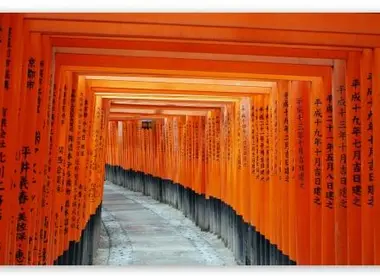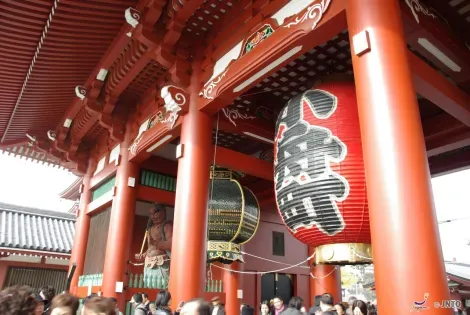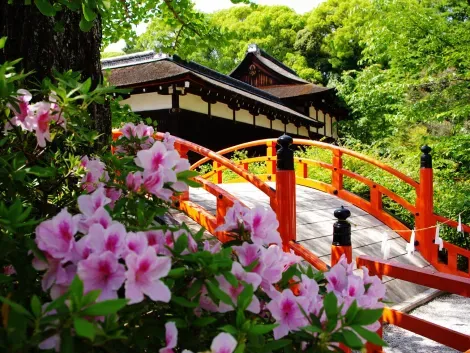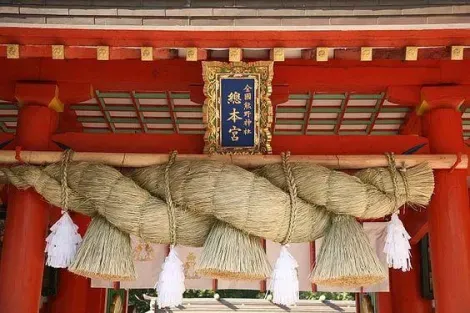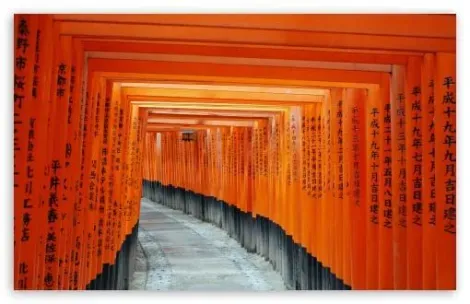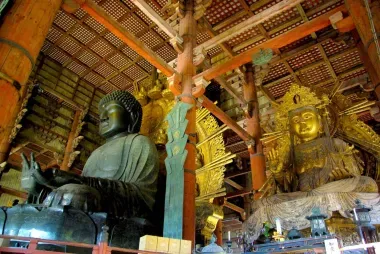Temples and shrines in Japan
- Published on : 01/07/2024
- by : J.L.T.B. / A.B.
- Youtube
Buddhist temples and Shinto shrines are essential elements of Japan's cultural and spiritual landscape. These sacred sites, scattered throughout the archipelago, reflect the country's rich religious history and play a central role in the daily lives of the Japanese people. From the smallest neighborhood shrine to the largest religious complex, these buildings bear witness to Japan's unique architectural and spiritual heritage. Their importance goes far beyond mere religious practice, embodying Japanese cultural identity and attracting millions of visitors every year, both local and foreign, fascinated by their beauty and profound significance.
Differences between Buddhist temples and Shinto shrines
Although often confused by foreign visitors, Buddhist temples and Shinto shrines differ significantly in their architecture, function and ritual practices. Shinto shrines, known as jinja (神社), are dedicated to the kami, the deities of the Shinto religion. They can be recognized by their torii (鳥居), the traditional gate marking the entrance to the sacred space. Buddhist temples, on the other hand, called tera (寺) or ji (寺), house Buddha statues and are generally more complex in structure.
The main difference lies in the spiritual approach: Shintoism focuses on the veneration of the forces of nature and ancestors, while Buddhism concentrates on attaining enlightenment and liberation from the cycle of reincarnation. This distinction is reflected in the rituals practiced in each place: worshippers clap and ring a bell in Shinto shrines, while they burn incense and recite sutras in Buddhist temples.
Architecture and composition of Japanese places of worship
The architecture of Japanese temples and shrines is a fascinating blend of tradition and innovation. Shinto shrines are characterized by their simplicity and harmony with nature. The main building, called a honden, houses the sacred object representing the kami. It is often preceded by a haiden, prayer hall, and a heiden, offering room. The whole structure is generally built of wood, with little decoration, reflecting the minimalist Japanese aesthetic.
Buddhist temples, on the other hand, feature more elaborate architecture. The main building, the hondo, contains the statue of Buddha. There is often a multi-storey pagoda, symbolizing the elements of the universe. The temples are decorated with intricate carvings and colorful paintings, testifying to the continental influence on Japanese Buddhism.
A common feature of both types of building is the care given to the surrounding gardens. These carefully landscaped green spaces play an important role in creating an atmosphere of serenity and contemplation, essential to the Japanese spiritual experience.
The main schools of Buddhism in Japan
Buddhism in Japan is divided into several major schools, each with its own teachings and practices. Among the most influential are :
- Zen, introduced in the 12th century, emphasizes meditation and self-discipline. The Rinzai and Soto schools are the best known.
- Pure Land Buddhism (Jodo), which promises salvation through devotion to Amida Buddha.
- Shingon, a form of esoteric Buddhism rich in complex rituals.
- Nichiren, founded in the 13th century, which focuses on the Lotus Sūtra.
Each school has left its mark on Japanese temple architecture and practices. Zen temples, for example, are known for their meditative stone gardens, while Shingon temples are often adorned with intricate mandalas.
Rituals and practices in temples and shrines
Rituals and practices in Japanese temples and shrines are deeply rooted in the country's daily life and traditions. In Shinto shrines, visitors generally follow this ritual:
- Purify hands and mouth at the water fountain (temizuya)
- Bow twice to the shrine
- Clap hands twice to attract the attention of the kami
- Say a silent prayer
- Bow one last time
In Buddhist temples, practices include :
- Lighting incense sticks
- Recitation of sutras
- Meditation, particularly in Zen temples
- Offering coins and praying before Buddha statues
These rituals vary according to the occasion, with special ceremonies for the New Year (Hatsumōde), weddings and seasonal festivals. The practice of prayer in these sacred places offers Japanese and visitors alike a moment of reflection and connection with their spirituality.
Famous temples and shrines to visit
Japan is home to many famous temples and shrines, each offering a unique experience. Among the most notable:
- Fushimi Inari Shrine in Kyoto, famous for its thousands of red torii
- Kinkaku-ji (Golden Pavilion) temple in Kyoto, a masterpiece of Buddhist architecture
- Ise Shrine in Mie Prefecture, dedicated to the sun goddess Amaterasu
- Senso-ji temple in Tokyo, the oldest in the capital
- Itsukushima Shrine on the island of Miyajima, famous for its "floating" torii
These sites attract millions of visitors every year, offering a glimpse of Japanese history, art and spirituality. Each has its own unique architectural features and atmosphere, reflecting different periods of Japanese history and religious influences.
The cultural and social importance of places of worship in Japan
Temples and shrines play a central role in Japanese cultural and social life, far beyond their religious function. They serve as landmarks in local communities, hosting seasonal festivals (matsuri) that bring people together and perpetuate traditions. They are also guardians of traditional arts and crafts, preserving national treasures and ancestral techniques.
For many Japanese, visiting these sacred places is an integral part of life's important moments: the birth of a child, New Year, school exams, or weddings. Temples and shrines also offer a space for peace and reflection in the hectic pace of modern life, contributing to the psychological and spiritual well-being of the population.
In addition, these sites play a significant economic role, attracting tourists from all over the world and supporting local economies. They are also places of education, passing on traditional history and values to younger generations.
Challenges and the future of Japanese temples and shrines
Despite their cultural importance, Japanese temples and shrines face many challenges in the modern world. The decline in religious practice, particularly among the younger generation, raises questions about the sustainability of some less-frequented sites. An aging population and rural exodus also threaten the survival of many small temples and shrines in rural areas.
The high cost of maintaining historic buildings and the difficulty of finding successors for priests and monks are other major challenges. Faced with these challenges, many temples and shrines are seeking to reinvent themselves, offering more modern activities such as meditation sessions for businesses, vegetarian cooking classes, or using social networks to attract a younger audience.
The future of these sacred places will depend on their ability to adapt while preserving their spiritual and cultural essence. Initiatives such as opening certain temples to spiritual retreats for foreigners, or integrating modern technologies into heritage presentation, point to possible ways of ensuring their continued relevance in contemporary Japanese society.
In conclusion, Japan's temples and shrines remain essential pillars of Japanese culture and identity. Although they face considerable challenges, their ability to evolve while preserving their spiritual heritage augurs well for a future in which they will continue to play a vital role in Japanese society. Discover Japan's most beautiful temples and shrines at your leisure with a Japan Rail Pass, and plunge into the heart of this fascinating thousand-year-old culture.
Temples and shrines
Other themes :
- Train in Japan
- Attractions and Excursions
- Before you Travel
- Books on Japan
- Events and Festivals
- Family Travel
- Getting Around Kyoto
- Getting Around Tokyo
- Itineraries for Japan
- Japanese Food and Drink
- Japanese History
- Japanese Language
- Japanese Movies
- Japanese Pop Culture
- Japanese Stations
- Markets in Japan
- Museums and Galleries
- Nightlife in Japan: Going out, seeing and drinking
- Onsen, Hot Springs and Public Baths
- Outdoor Activities

